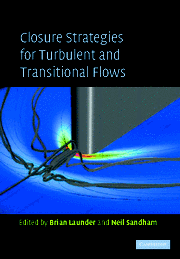22 - Simulation of Coherent Eddy Structure in Buoyancy-Driven Flows with Single-Point Turbulence Closure Models
Published online by Cambridge University Press: 06 July 2010
Summary
Introduction
A major deficiency of conventional single-point closure models that are used in conjunction with Reynolds-averaged Navier–Stokes methods (RANS) is in their inability to account for a wide range of turbulence time and length scales, which characterize various mechanisms in turbulence dynamics. By their nature, RANS methods conceal any spectral and structural information, and have been regarded as unsuitable for detecting any identifiable eddy structure. This, in turn, prevents accounting for any spectral features, interactions between eddies of different scales and energy transfer through the spectrum. Yet, it is known that the spectral dynamics is different in every flow and influences the gross turbulence features. Single-point RANS closures compensate for these deficiencies partially by various additions to the basic model to account nominally for departure from the simple flows in which they were tuned and thus, indirectly, for spectral non-equilibrium.
A way to partially overcome the problem is to introduce one or more additional turbulence scales by which to represent distinct parts of the turbulence spectrum. Such multi-scale models have been proposed e.g. by Hanjalić, Launder and Schiestel (1980), Schiestel (1987) and others. Here the turbulence energy spectrum is divided into two or more parts, and the transport equations for turbulent kinetic energy (or the full stress tensor)and for the energy dissipation rate are solved for each spectral slice, including also their mutual interaction. Other multiple-scale models have also been proposed in the literature, with moderate success. A major problem appears in the large number of unavoidable empirical coefficients, which are difficult to determine because of the lack of information on spectral dynamics in various flows. More advanced spectral models, that account fully for spectral dynamics have also been proposed (e.g. Besnard et al. 1996, Touil et al. 2000). These models look promising, but have not yet been widely tested and it is uncertain how suitable and attractive they are for predicting real complex flows.
A particular problem arises when the flow is dominated by large coherent vortical structures. These large-scale eddies can be discerned in many turbulent flows whether in the laboratory, in nature or in industrial appliances. They act as a major carrier of momentum, heat and species. In wall bounded non-isothermal flows, where the walls are at different temperatures, these eddies often provide the major communication link between the bounding walls and thus control the exchange of heat between them.
- Type
- Chapter
- Information
- Closure Strategies for Turbulent and Transitional Flows , pp. 659 - 684Publisher: Cambridge University PressPrint publication year: 2002
- 5
- Cited by



